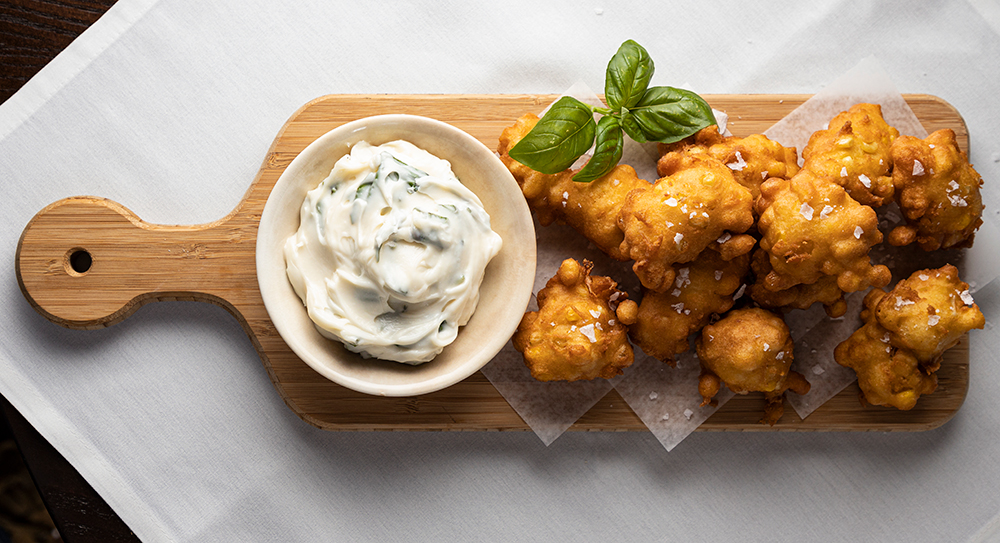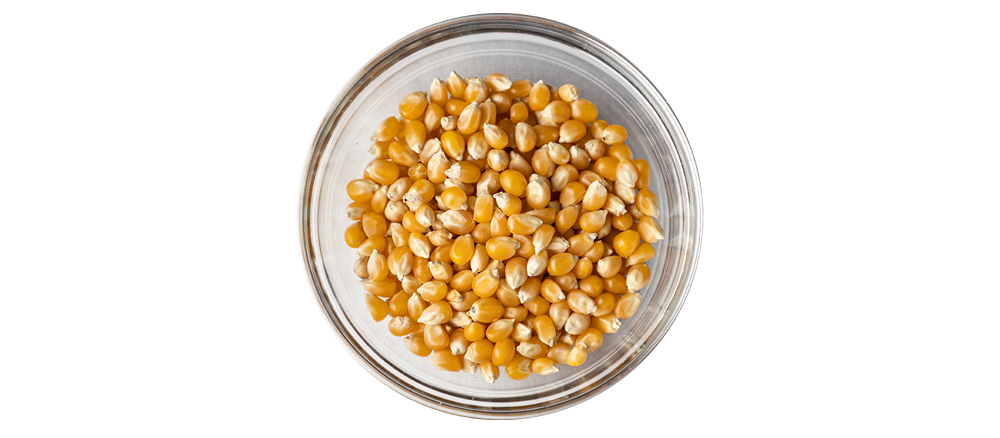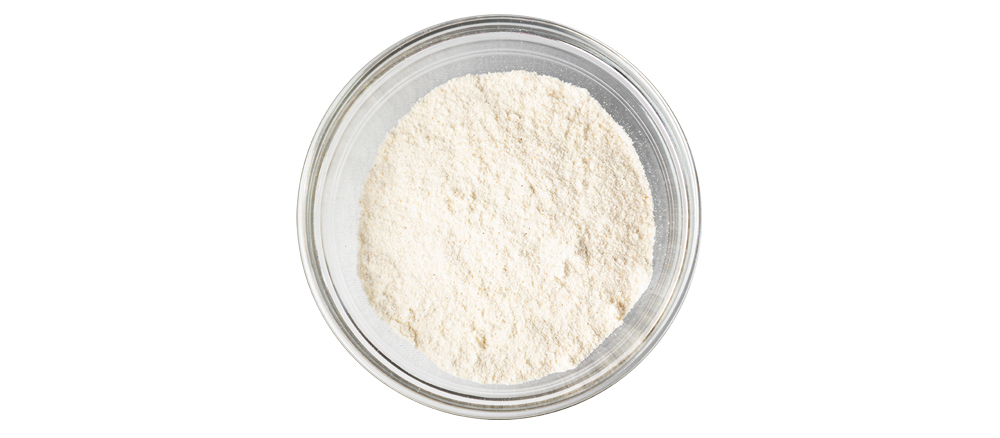
Growing up in Arkansas, I was familiar with only a few preparations of corn: on the cob with butter, ground into cornmeal and used for cornbread or a coating for frying catfish, and from a can (the creamed kind, which my father loved but I intensely disliked—whole-kernel canned corn was moderately acceptable but not something I would cross the street for). Hush puppies, grits, and corndogs were on the periphery—marginal foods—and I was a very picky eater. Moving to Kansas City almost 30 years ago, I discovered a whole new world of corn, grilled whole, sometimes still in the husk, in succotash, then—polenta. I remember excitedly taking it back to prepare for my family. “This is cornmeal mush—grits?” my father stated. No, it was definitely not (it was actually, after a fashion). Besides, the grits at IHOP were white. I had so much more to learn.
To keep it brief, corn (maize) comes in two broad varieties, flint and dent, although some scientists like to divide it into even more categories. Flint corn has a hard starch center with rounded kernels (like popcorn), is difficult to mill, and is typically used for making polenta. Dent corn kernels have a softer starch center with a dent in the top. They are easy to mill and are mostly used (in the South) for cornmeal and grits, but there are all manner of variations and exceptions to the rule. For more information than you will probably ever need, visit the corn section of the website for Anson Mills, some really enthusiastic growers and millers of heirloom and artisan grains in South Carolina (ansonmills.com). Whether using corn in its fresh, sweet state, or dried and ground, most people are just happy knowing what tastes good.
For me, simple boiled or steamed corn on the cob with butter and salt is still a favorite. I always wait a week or two after corn appears at the market, then buy two dozen ears, and shuck and freeze them as soon as I get home, no processing necessary. That takes care of my requirements for the next nine months or so. Multiple attempts at growing corn at my home in woodsy Waldo have failed miserably—can’t compete with the squirrels (I once built a chicken-wire cage around a stand of corn—not easy—secured and sewn up with wire so nothing could get in. I woke up one morning to find a cage filled with fat squirrels who were desperate to get out). Small corn pancakes are lovely as well—use the cobs to infuse corn flavor into the liquid component of the batter for more intense corn flavor. Thanks to my Southern heritage and love of all things Italian, dried corn in the form of flour and meal is a staple in our household for polenta, cornbread, cakes, and fritters, and I continue to discover new techniques and recipes to use this gratifying grain. Learning, it turns out, is one of the most pleasurable aspects of cooking and being a gardener. For good curious cooks and gardeners, it never stops. I hope you enjoy these fritters, which make use of corn in both fresh and dried form.
Corn Fritters
Corn fritters are a tasty way to use up leftover cooked corn, either cut off the cob from boiled corn or corn grilled or roasted in the husk. Frozen kernels could work as well. This fritter is light and puffy—not crunchy or crispy—delicious on its own or as an accompaniment to a meal. For about 2 cups of cooked corn kernels (the leftovers from three or four ears of corn), separate 2 whole eggs, reserving the whites, and combine the yolks with about 3 tablespoons milk in a medium-sized bowl. In another bowl, combine ¼ cup all-purpose flour, 1 teaspoon baking powder, 2 tablespoons sugar, a good dash of salt and about ½ cup flavorful corn flour or very fine cornmeal (like corn flour from Bob’s Red Mill or Antebellum Fine Yellow Cornmeal from ansonmills.com). Mix the dry ingredients into the wet ingredients. The batter can be made to this point up to a day in advance. When ready to serve, in yet another bowl, whisk the 2 reserved egg whites to soft peaks, then fold them into the corn mixture. If you make these every day and would like to add a little variation, try adding a small handful of a chopped herb, such as fresh basil, chives, or thyme leaves. If the batter seems impossibly loose—thinner than pancake batter—you have made it correctly. Carefully fry heaping tablespoons of the batter in either a skillet with a generous amount of oil or in a deep fryer set at 350F. Don’t make the dollops of batter too big or they will not cook all the way through before they are done on the outside. If cooking in a skillet, turn the fritters after they have set on the bottom and continue to cook until they are a beautiful golden brown all over. If you like to dip, aioli or a little mayo with basil mixed in is a nice accompaniment. Serve warm, with a generous helping of summer.
In Your Pantry: More Corn
Corn/Maize is an incredibly versatile crop. Over the centuries, different varieties of this starchy wonder have been bred for different purposes, and different techniques for grinding and using corn are what separate one from the other.
Popcorn: Not the kind in the packet that gets thrown in the microwave with its own unnatural flavorings. Rediscovered (in the back of the pantry) by many desperate cooks during the pandemic quarantine, popcorn is an extremely versatile vehicle for flavor both savory and sweet. Cacio e Pepe (cheese and pepper), sage brown butter, ranch, sriracha-lime, barbecue, maple-pecan, caramel and sea salt—the sky’s the limit!
Coarse Polenta: For the most robust flavor and texture in polenta, use coarsely ground yellow corn polenta from either Italian or artisan American producers like Anson Mills and Bob’s Red Mill. Coarse polenta takes a minimum of 40 minutes and up to an hour to cook, but the time invested is returned in volumes of flavor. Some call this grits as well—it’s a long discussion.
White Polenta: Just like there are different colors of and grinds of corn, there are also different colors of polenta. Popular especially around Venice, white polenta typically is more subtly flavored and has more floral, dairy-like notes. Try it for your next round of shrimp and grits.
Cornmeal: The American standard for everyday cornbread and muffins. The texture is good for baking but makes sorry polenta. Grocery store varieties are reliable, but there is a whole world of diversity to explore. Check the internet.
Masa: AKA masa harina (common name brand Maseca), is the product of soaking and cooking corn kernels in an alkaline solution (usually water and lime or wood ash), a process called nixtamalization. The kernels (now known as hominy) can then be hulled and ground to make flour. Flour that has undergone this process can be made into a dough—tortillas would be impossible without it. The process also makes more nutrients available to humans.






